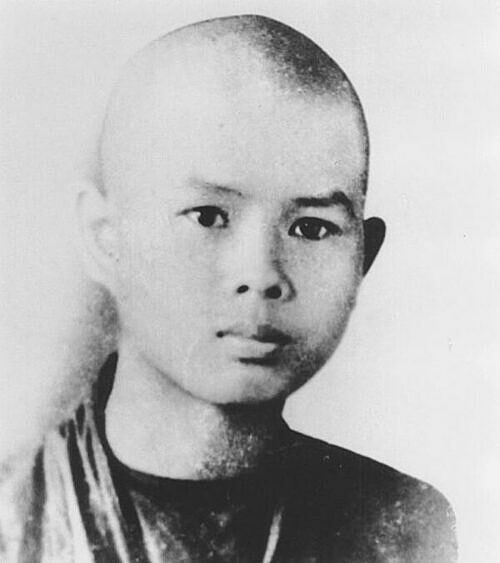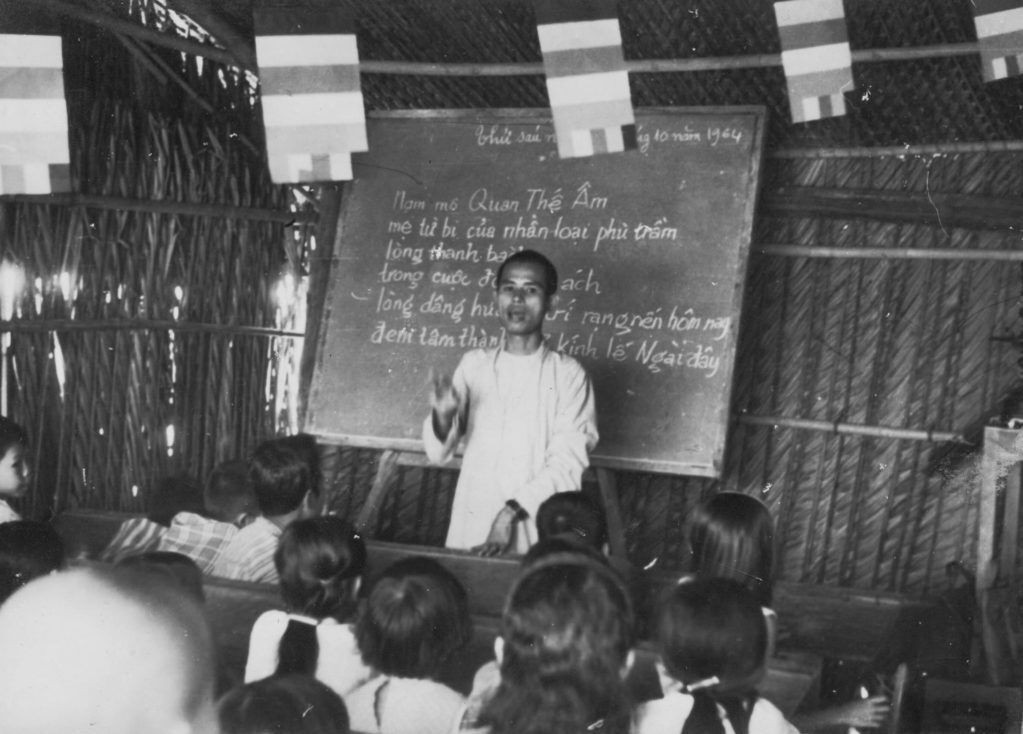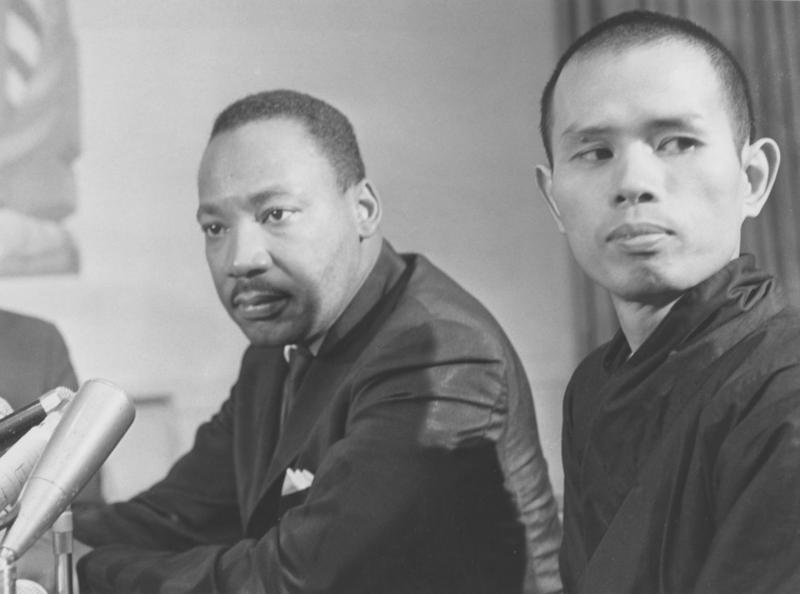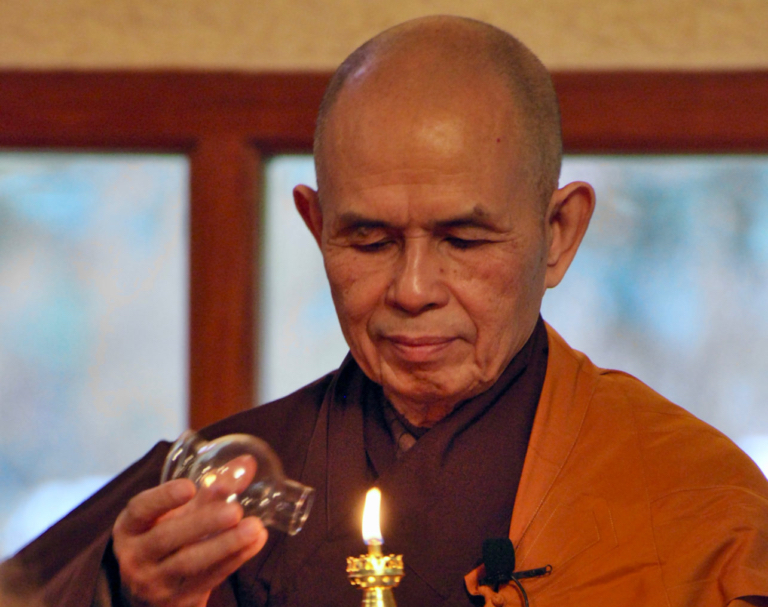Throughout his life, Thich Nhat Hanh nurtured the “Engaged Buddhism” movement, called for peace and spread its teachings to the world.
Born in 1926 in Thua Thien-Hue as Nguyen Xuan Bao, he and the rest of his family moved to the mountainous area in the north of Thanh Hoa Province when he was five to be with his father, dispatched to the region a year prior to monitor forest clearance.
Besides his time at school, the young Bao learned several other languages like French and Old Chinese. He was also interested in books and articles about Buddhism that his brother brought home.
Bao recounted a moment when he was nine years old and saw the image of the Buddha on the cover of a magazine. The Buddha’s image of serenity and tranquility was a stark contrast to the pain and inequality people had to face at the time, when the country was still under French dominance. It left a lasting impression on him and made him realize his wish to help others experience that same feeling of peace.
 |
|
Zen Master Thich Nhat Hanh at the age of 16. Photo courtesy of the Plum Village Community of Engaged Buddhism |
When he was 12, his brother decided to leave home and become a monk. His parents at the time naturally did not sit well with his decision, knowing a tough life awaited him if he chose a similar path. When his family agreed, he joined his brother at Tu Hieu Pagoda for training.
In 1949, he and two of his friends left Hue for Saigon at the age of 23. During their journey to become monks, the three friends decided to choose new names appropriate to their new spiritual vocation. They made sure to include the term “Hanh,” which means “action.” Hanh settled with “Nhat Hanh,” meaning “sole action.” Since then, he became known as Thich Nhat Hanh.
In 1950, he and his master Tri Huu built An Quang Pagoda. The pagoda later became an institute for Buddhist studies. The same year, he published his first book on Buddhism called “Dong Phuong Luan Ly Hoc” (Oriental Logic).
By the end of 1952 in Da Lat, Thich Nhat Hanh and his brother set up Tue Quang primary and middle school, the first private school for Buddhism managed by monks. In 1954, he became superintendent at the Nam Viet Buddhist school and studied at Saigon Literature University.
 |
|
Thich Nhat Hanh teaches children to read and write in 1964. Photo courtesy of the Plum Village Community of Engaged Buddhism |
Thich Nhat Hanh incorporated knowledge from multiple Buddhist disciplines and certain discoveries of modern Western psychology to create a new approach towards meditation. He was also the one who coined the term “Engaged Buddhism” in the “Vietnam: Lotus in a Sea of Fire” book.
“Engaged Buddhism is just Buddhism. When bombs begin to fall on people, you cannot stay in the meditation hall all the time. Meditation is about the awareness of what is going on – not only in your body and in your feelings, but all around you,” he explained in an interview with journalist John Malkin in 2003.
“Buddhism has to do with your daily life, with your suffering and with the suffering of the people around you. You must learn how to help a wounded child while still practicing mindful breathing. You should not allow yourself to get lost in action. Action should be meditation at the same time,” he said.
In 1956, he became chief editor for the Vietnamese Buddhism magazine. In the 1960s, he helped develop the School of Youth for Social Service (SYSS), a Buddhist peace worker organization that helped build schools, medical stations and supported homeless families.
He was also a founder of Van Hanh University, a prestigious private school that has produced several researchers on Vietnamese Buddhism, culture and language. In a meeting in April 1965, students at the school called for peace and a solution to end the Vietnam War.
Thich Nhat Hanh traveled to the U.S. multiple times for research and to deliver speeches at Princeton and Cornell universities. He later taught at Columbia University. His main purpose during his time abroad was to call for peace.
In June 1965, he wrote to U.S. activist Martin Luther King Jr., callin on him to publicly oppose the Vietnam War. A year later, the two met for the first time in Chicago and discussed peace, freedom and community. At a later press meet, King voiced his opposition to the Vietnam War. In 1967, he nominated Hanh for a Nobel Peace Prize, but to no avail.
Thich Nhat Hanh expressed disbelief upon hearing about King’s assassination in 1968.
“The American people produced King but were not capable of preserving him. I was a little bit angry. I did not eat; I did not sleep. But my determination to continue building a beloved community continued,” he said.
 |
|
Thich Nhat Hanh (R) meets with Martin Luther King Jr. in 1966. Photo courtesy of Sweeping Zen |
In 1966, he established the Order of Interbeing based on traditional Buddhist bodhisattva precepts, expressed with an innovative vision of a modern, engaged Buddhism. He remained abroad since the Paris Accord was signed in 1973, living at Plum Village Monastery in France.
As one of the masters of Buddhism in the West, his teachings and methods have garnered the attention of many people due to his stance on religion, spirituality and politics. He introduced a method of mindfulness adjusted to align with Western thought.
“When you hold the hand of a child, invest one hundred percent of yourself in the act of holding her hand. When you hug your partner, do the same. Forget everything else. Be totally present, totally alive in the act of hugging. This is the opposite of the way we’ve been trained to lead our lives and run our businesses. We’ve been taught to do many things at once. We answer an email while we talk on the phone; while in a meeting for one project, we work on our notes for another project. Every new technology promises to help us do more things at once. Now we can send emails while listening to music, talking on the phone, and taking a picture, all with the same device. With your energy that dispersed, where is your power?” he wrote in his book “The Art of Power.”
He believed practicing mindfulness would help people recognize their pain and transform them.
As a pioneer in bringing Buddhism, especially the practice of mindfulness, to the Western world, Thich Nhat Hanh created a community of “Engaged Buddhism” with around 1,250 disciples at Plum Village Sangha. Millions of other call themselves his disciples across the globe.
He had written over 120 books, including 40 in English. Some of his most notable works include “Old Path, White Clouds: Walking in the Footsteps of the Buddha,” “The Miracle of Mindfulness: A Manual on Meditation” and “Touching the Earth: Intimate Conversations with the Buddha.”
Thich Nhat Hanh also organized meditation courses for several Israelis and Palestinians, encouraging them to listen and learn from each other, calling for the cessation of conflict while seeking peaceful solutions. In 2005, he organized a march for peace in Los Angeles, with the participation of thousands of people.
In May 2013, in a speech lasting three hours at a stadium in South Korea, he discussed the relationship between South Korea and North Korea.
“Nuclear weapons are an obstacle to good relations between South Korea and North Korea. It reflects our fear, anger, and suspicion. If we weren’t angry or scared, we would not be building nuclear weapons,” he said.
According to him, the key to conflict resolution was to listen. He also advised politicians to follow the teachings of Buddhism to help with diplomacy and negotiation.
After over four decades away from home, he returned to Vietnam in 2005 and 2007. He traveled the country, organizing meditation courses and meetings with people. In 2007, he organized three “Great Chanting Ceremonies” called the “Grand Requiem for Praying” to help heal wounds left by the Vietnam War. He was invited back to Vietnam as main presenter of the Vesak Ceremony in Hanoi in 2008.
In October 2018, he returned from Thailand to Tu Hieu Pagoda to live out the rest of his days, up until he passed away.
 |
|
Zen Master Thich Nhat Hanh. Photo courtesy of Plum Village |
For his lifelong, restless quest for peace, Thich Nhat Hanh became the second-most influential Buddhist leader who in the Western world, behind the Dalai Lama, an AP article wrote in 2009.
The Huffington Post in 2012 called him the “calmest man in the world.”
U.S. talk show host Oprah Winfrey, who interviewed him in 2009, lauded his teachings as inspirational.
Researcher Nguyen Dac Xuan, who had interacted with him several times, said his “Engaged Buddhism” philosophy has helped him put Vietnamese Buddhism on the global stage and was influential among intellectuals.
Thich Nhat Hanh passed away at Tu Hieu Temple in his birthplace Hue on Saturday, aged 95. His funeral will take place over seven days as a silent meditation course.
- Reduce Hair Loss with PURA D’OR Gold Label Shampoo
- Castor Oil Has Made a “Huge” Difference With Hair and Brow Growth
- Excessive hair loss in men: Signs of illness that cannot be subjective
- Dịch Vụ SEO Website ở Los Angeles, CA: đưa trang web doanh nghiệp bạn lên top Google
- Nails Salon Sierra Madre
 VnExpress News The News Gateway of Vietnam
VnExpress News The News Gateway of Vietnam





